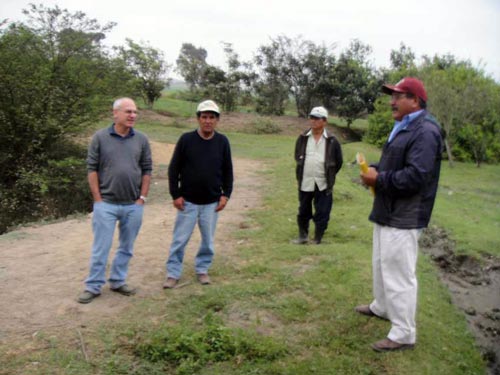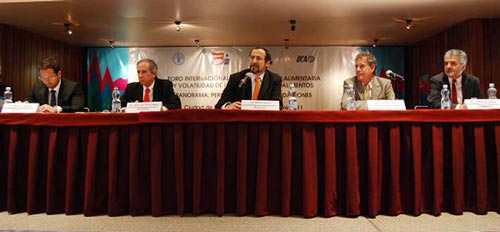The 11th Asian Maize Conference “Addressing climate change effects and meeting maize demand for Asia” took place during 07-11 November 2011 in Nanning, China. Nearly 375 scientists and resource personnel from 22 maize-growing countries participated, along with representatives of several large seed companies and NGOs.
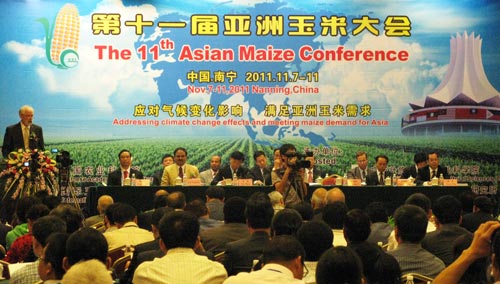
The conference was jointly organized by CIMMYT and the Chinese Academy of Agricultural Sciences (CAAS), and hosted by the Guangxi Academy of Agricultural Sciences (GXAAS) and the Guangxi Maize Research Institute (GMRI). The choice of location recognizes the increasing demand for maize in China; whilst China grows more maize than any other crop, and produces 180 million tonnes annually, it also imports nearly 14 million tonnes. China’s expanding middle class is eating more poultry, eggs, and pork; meat consumption in China has tripled since 1980 and China currently accounts for half the world’s consumption of pork. Of the total maize produced in Asia, 70% is used to feed animals, whilst just 23% is used for direct consumption.
Maize consumption is also increasing in other Asian countries: in Indonesia, imports of maize are estimated to double from 2010 levels to 3.2 million tonnes this year, and at 16 million tones, Japan is the world’s largest importer of maize. These increases are expected to continue.
The conference was opened by Yangrui Li (President, GXAAS), Ren Wang (Vice-President, CAAS), Thomas Lumpkin (Director General, CIMMYT), and Chen Zhangliang (Vice-Governor, Guangxi Provincial Government). They highlighted the growing importance of maize in the developing world, especially Asia, and the need for strong international collaborations to address challenges in maize-based systems.
Keynote speakers included BM Prasanna (Director, Global Maize Program, CIMMYT), Shihuang Zhang (Chief Expert, Crop Science Institute, CAAS), Greg Edmeades (retired scientist and former CIMMYT Maize Physiologist), Daniel Jeffers (Maize Breeder, CIMMYT-China), Gary Atlin (Associate Director, Global Maize Program, CIMMYT), Roberto Tuberosa (University of Bologna, Italy), Kevin Pixley (Director, Genetic Resources Program, CIMMYT), Adrian Johnson (Vice-President, International Plant Nutrition Institute), Bekele Shiferaw (Director, Socioeconomics Program, CIMMYT), and Yiqing Song (CAAS), along with many invited speakers. They covered a range of topics from conservation agriculture systems, to site-specific nutrient management and nutritionally improved maize. Sessions also highlighted recent developments in the CIMMYT-led MAIZE comprehensive research program, including technological advances such as the use of double haploids, phenotyping tools, and the large-scale genotyping initiative, Seeds of Discovery.
Participants also discussed the increasing frequency of natural disasters in Asia, and the effects these have on food production. Floods in Pakistan, droughts in China, and water stress in India have all impacted the ability of Asian maize producers to meet consumption demands.
The conference concluded with a Maize Field Day, organized by Cheng Weidong at the GMRI research station, where landraces and promising hybrids were demonstrated. Participants praised the success of the conference, with Bijender Pal (Senior Maize Breeder, Bioseed) stating: “The conference was very well organized, with excellent lectures by the experts on various key aspects, and a comprehensive treatment of the key issues for maize in Asia.”
Warming up to the conference with the MAIZE Asia Interface
As a preface to the Asian Maize Conference, almost 70 scientists, representatives of private sector seed companies, members of the International Maize Improvement Consortium of Asia, and NGOs participated in the MAIZE Asia interface on 07 November 2011. Chaired by CIMMYT’s Director General, Thomas Lumpkin, the meeting aimed to present the main strategic initiatives and vision of the MAIZE project to key Asian partners and stakeholders, outline challenges, promote collaborations, and discuss how to disseminate relevant technologies for the benefit of smallholder maize farmers in Asia.
As part of the Cereal System Initiative in South Asia expansion in Bangladesh (CSISA-BD), 21 agricultural field staff and extension personnel from CIMMYT and the International Rice Research Institute (IRRI) undertook training on improved upland cereal and legume production systems during 01-02 November 2011 in Dhaka.

 On 14 November 2011 Thokozile Ndlela and Charles Mutimaamba of Zimbabwe’s Crop Breeding Institute received the DTMA Breeding Team Award for southern Africa. It was presented by Cosmos Magorokosho, CIMMYT Zimbabwe Maize Breeder, at a management meeting of the Department of Research and Specialist Services of the Ministry of Agriculture, Mechanisation and Irrigation Development of the Government of Zimbabwe, at their head office in Harare. The award consisted of USD 3000 and a silver tray that the winners will be able to display until it is reawarded next year.
On 14 November 2011 Thokozile Ndlela and Charles Mutimaamba of Zimbabwe’s Crop Breeding Institute received the DTMA Breeding Team Award for southern Africa. It was presented by Cosmos Magorokosho, CIMMYT Zimbabwe Maize Breeder, at a management meeting of the Department of Research and Specialist Services of the Ministry of Agriculture, Mechanisation and Irrigation Development of the Government of Zimbabwe, at their head office in Harare. The award consisted of USD 3000 and a silver tray that the winners will be able to display until it is reawarded next year.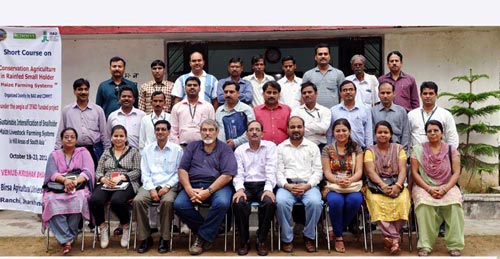
 An extraordinary session of the ASA/CSSA/SSSA convention in San Antonio, Texas, during 16-19 October 2011, honored researchers who have dedicated their professional lives to understanding and using the diversity of the amazing food crop, maize, and its wild relatives Tripsacum and teosinte. Entitled “The mysteries of maize: A recognition of pillars in maize science,” the session paid tribute to the careers of Major Goodman, Hugh Iltis, Takeo Ángel Kato Yamakake, Wilfredo Salhuana, José de Jesús Sánchez González, and H. Garrison Wilkes, as well as CIMMYT’s own Suketoshi Taba and José Crossa.
An extraordinary session of the ASA/CSSA/SSSA convention in San Antonio, Texas, during 16-19 October 2011, honored researchers who have dedicated their professional lives to understanding and using the diversity of the amazing food crop, maize, and its wild relatives Tripsacum and teosinte. Entitled “The mysteries of maize: A recognition of pillars in maize science,” the session paid tribute to the careers of Major Goodman, Hugh Iltis, Takeo Ángel Kato Yamakake, Wilfredo Salhuana, José de Jesús Sánchez González, and H. Garrison Wilkes, as well as CIMMYT’s own Suketoshi Taba and José Crossa.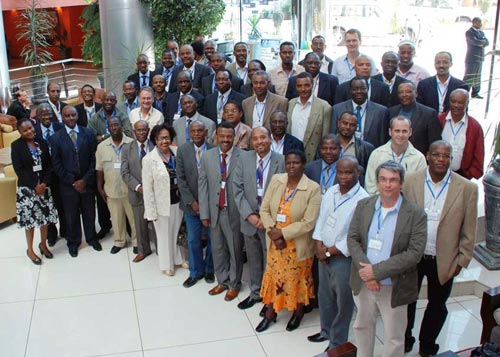 During 26-27 October 2011, seed policy experts met in Addis Ababa, Ethiopia, for a workshop on “Maize seed sector development in eastern and southern Africa”, to chart the way forward for the regions’ seed systems. The workshop was organized by CIMMYT as part of the Drought Tolerant Maize for Africa (DTMA) project, and brought together permanent secretaries of agriculture ministries, members of parliament, seed companies, seed traders associations, heads of research organizations, scientists, and seed regulators from eight of the project countries (Ethiopia, Kenya, Malawi, Mozambique, Uganda, Tanzania, Zambia, and Zimbabwe).
During 26-27 October 2011, seed policy experts met in Addis Ababa, Ethiopia, for a workshop on “Maize seed sector development in eastern and southern Africa”, to chart the way forward for the regions’ seed systems. The workshop was organized by CIMMYT as part of the Drought Tolerant Maize for Africa (DTMA) project, and brought together permanent secretaries of agriculture ministries, members of parliament, seed companies, seed traders associations, heads of research organizations, scientists, and seed regulators from eight of the project countries (Ethiopia, Kenya, Malawi, Mozambique, Uganda, Tanzania, Zambia, and Zimbabwe).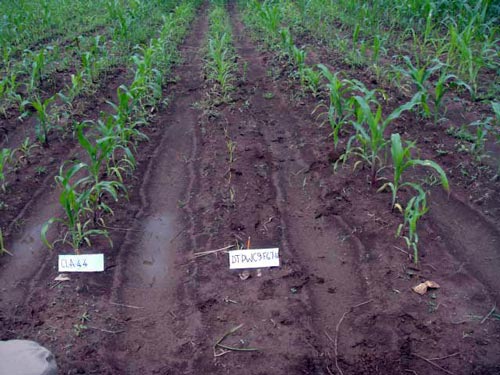 On 19 August 2011, a workshop was hosted by CIMMYT-Colombia for maize producers, association representatives, and educators and students from various local universities, among others, on the advances of a project to increase maize production in Colombia through the development of improved germplasm adapted to the production systems in the Orinoquía region (East Plains). The Orinoquía is an area of plains, covered by pasture and interspersed with rivers and forests; all the rivers terminate in the Orinoco river. The project is coordinated by CIMMYT-Colombia, with support from the Colombian Agricultural Research Cooperation (CORPOICA), Colombian Growers Federation of Cereals and Legumes (FENALCE), International Center of Tropical Agriculture (CIAT), and the Ministry of Agriculture and Rural Development of Colombia. The workshop took place at the CORPOICA Research Center in Villavicencio, Del Meta District.
On 19 August 2011, a workshop was hosted by CIMMYT-Colombia for maize producers, association representatives, and educators and students from various local universities, among others, on the advances of a project to increase maize production in Colombia through the development of improved germplasm adapted to the production systems in the Orinoquía region (East Plains). The Orinoquía is an area of plains, covered by pasture and interspersed with rivers and forests; all the rivers terminate in the Orinoco river. The project is coordinated by CIMMYT-Colombia, with support from the Colombian Agricultural Research Cooperation (CORPOICA), Colombian Growers Federation of Cereals and Legumes (FENALCE), International Center of Tropical Agriculture (CIAT), and the Ministry of Agriculture and Rural Development of Colombia. The workshop took place at the CORPOICA Research Center in Villavicencio, Del Meta District.
